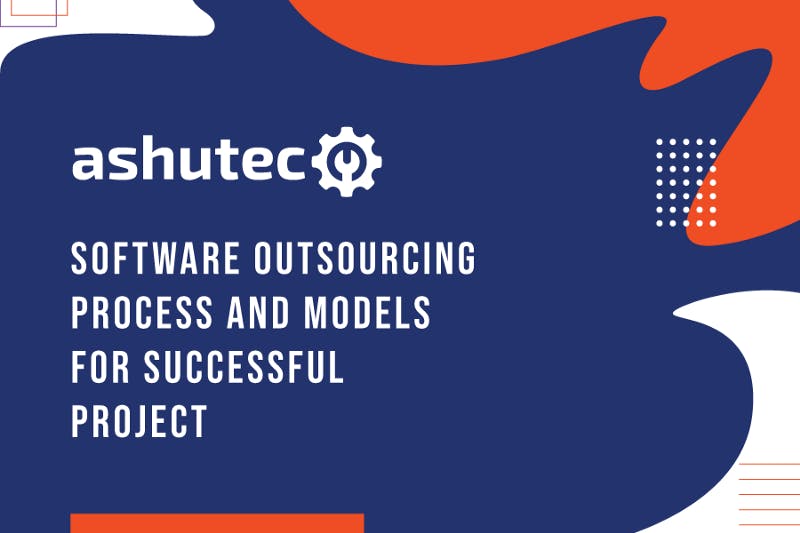Let’s Connect!
Work can be a fun when we know and understand each other well. Let's start conversation to new beginning
+91 63542 35108
To discuss what we can do for you Give us a Call
connect@ashutec.com
Tell us about your next project Write to us

The software outsourcing process commences when a business — facing certain limitations — decides to employ a third party to carry out the work on its behalf. Outsourcing software development projects to a trusted development partner enables you to get acquainted with top-notch web, mobile, and other software products.
Not only, but outsourcing offers several benefits and other positives that enterprises and individual software developers can experience. So, if employing trusted third-party software developers resonates with you, here’s a step-by-step procedure for outsourcing software development projects:
The following guide helps you navigate through your outsourcing journey for hiring a reliable outsourcing partner.
Without clear and concise goals and expectations, the outsourcing team would find it difficult to comprehend the software development project. Thus, the first step before you do anything is to prepare a detailed project outline, what features to include, what technology to use, and a timeline for completion.
Include your internal team or even the people you know from your business relations if possible for a brainstorming session. This would help you ensure your software development projects sound interesting and achievable.
Preparing the scope of work is the next step in the process of outsourcing software development. It does not make sense to reach out to a software outsourcing partner without any documentation that clearly outlines the objective and scope of work.
Devising such documents would require things such as product specification documents, plans, budget estimates, system admin documents, and other reports. These are just the tip of the iceberg, there are a whole bunch of things needed depending on the type of project.
Finding a trusted and reliable software outsourcing partner is a tough nut to crack. The right software development agency is decided based on the project requirements, goals, and scope of work.
The first thing you should do is get references from your team, colleagues, and business partners, or just google it. Also, there are various company comparisons and review sites such as clutch to find a reliable outsourcing company.
Shortlist some of the agencies and filter out to find the best and most reliable one to do the job. To shortlist companies, you’d have to do a bit of research first, which can be a tedious task but have huge implications for your software development project.
There are certain ways to research and find the best outsourcing agencies such as checking out their portfolio, reviews/testimonials from past clients, years of experience, etc.
The first interaction with the agency of your choice is going to be crucial. You can approach more than one agency with similar interests and interview them to get an idea if they are experts in their field or not.
Schedule a video interview or a phone call to establish a personal relationship. Here are a few things you should discuss while on a call with the outsourcing agency:
Invite the outsourcing partners of your choice and get to know them for better understanding and relationship.
In the software outsourcing process, testing and quality assurance (QA) are crucial procedures to make sure the finished product meets the necessary quality requirements and performs as intended.
User acceptability testing verifies that the program satisfies end users' requirements and expectations. The software testing and quality assurance process aids in locating and resolving any issues with the program before launch, enhancing the final product's quality and lowering the possibility of difficulties occurring after launch.
Software outsourcing has many benefits, including helping businesses make sure that the project is on track and producing the expected results by monitoring and measuring progress.
Organizations can make any required adjustments to ensure that their outsourcing software development project is achieving the desired results by monitoring and measuring success.
Most sophisticated software development agencies have their own standards which they follow for efficient work. Knowing such standards and models of work during the interview process would be imperative.

Also, it’s a subtle way to let others know and look more professional while explaining the outsourcing models. Here are the software outsourcing models mostly in use:
One of the simplest models of outsourcing, the staff augmentation model is where the software development tasks are carried out by the outsourcing team. In simple terms, it’s like leasing a team of experts from other agencies, be it onshore or offshore, and providing them with tasks to work on and complete the project.
It sounds similar to an offshore development center where you set up a whole team of experts to carry out your software development project.
Also known as team augmentation, this outsourcing model enables your in-house team to maximize development efficiency while retaining control over the project. Aspects like defining the work process, managing the project to work on, etc. are controlled by the client.
A dedicated or managed team outsourcing model is where you outsource your software development project to a dedicated team of experts. Here. you’ll get a couple of developers to work and complete specific tasks and project delivery pipeline.
Also, you’ll have direct access to the team leaders and project managers that take care of the software delivery schedule to ensure the project stays on track.
The client is still in control of making software development decisions and can control projects individually. However, they can pass on a great deal of decision-making to the outsourcing providers in cases where a software product is required to be maintained.
The Lean Model is a project management strategy that is based on the ideas of the Lean methodology, which emphasizes cutting out waste and continuously improving processes. Delivering high-quality software as rapidly and effectively as feasible is the aim of the lean model.
The team working on a lean project concentrates on finding and removing waste in every stage of the project, including development, testing, and deployment. By streamlining the development process, the project can be finished in less time and with fewer resources.
The Lean Model also places a strong emphasis on regular input from stakeholders and close team cooperation, which helps to guarantee that the supplied software matches the needs and expectations of the client.
The Lean Model is most successful for projects with complex and changing requirements since it can produce results quickly and with excellent quality. It is a flexible and adaptable method of project management since it can be modified to match a range of project sizes and types.
In the project-based outsourcing model, your only concern is the result which is the software product, and not the means behind it. Here, your development partner looks after and manages the entire software development process as per the specifications and requirements provided before project commencement.
The client hands off the requirements to the outsourcing partner, who is responsible for developing and delivering the final product. Although the client has the least amount of control, they still can have some oversight to ensure that the product quality remains intact.
The hybrid model combines two or more project management approaches and is specifically designed to address the unique needs and specifications of a project. By minimizing their shortcomings, this approach enables businesses to benefit from the advantages of many project management models. For instance, a company might combine the Waterfall and Agile methods, using a systematic planning and design process while being flexible and adaptable during the development and testing phases.
The Hybrid Model offers a more individualized and personalized approach to project management, enabling firms to align their procedures with their unique aims and objectives. Nevertheless, compared to a single, isolated project management approach, it might also be trickier and more difficult to deploy.
In general, businesses that need to manage complex, dynamic projects and want to be more flexible and adaptable in their approach can benefit from the hybrid model.
Software outsourcing models help you get started with your journey to software development. Once you have established who’ll have more control over project decisions, you must tick off the following things for successful completion.
Outsourcing software development has countless positive outcomes for your business. It saves money and time and also enables you to get high-quality solutions from a team of experts. Now the only thing between you and an outsourcing software project is choosing the model that suits your requirements best.
Also, through the steps listed in the outsourcing process above, you must first define your goals, requirements, the scope of work, etc. before finding and reaching out to a reliable outsourcing partner.
Speaking of the same, Ashutec Solutions Pvt Ltd. is a reliable outsourcing services provider trusted by many small to large enterprises. Our experienced and adept team of professionals is ready to serve you and offer you unique, scalable, and maintainable software and product development solutions.
Contact us today or write to us at connect@ashutec.com for more discussion on the topic. Also, follow ashutec for reading more such articles.

